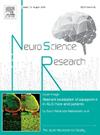Fibril-seeded animal models of synucleinopathies: Pathological mechanisms, disease modeling, and therapeutic implications
IF 2.3
4区 医学
Q3 NEUROSCIENCES
引用次数: 0
Abstract
Accumulating evidence suggests that prion-like spread of misfolded α-Synuclein (αSyn) underlies the pathological progression of Lewy body diseases (LBD). Animal models injected with αSyn preformed fibrils (PFFs) have provided strong evidence for the prion hypothesis in LBD. Moreover, αSyn PFFs can be administered to various hosts and regions, contributing to the elucidation of pathological mechanisms and disease modeling. These models have also been used to identify biomarkers and develop new disease-modifying therapies for LBD. In contrast, it remains unknown how the prion-like properties of αSyn contribute to the pathogenesis of multiple system atrophy (MSA). Recent studies indicate that conformationally distinct αSyn fibrils induce different pathological features in animals, supporting the strain hypothesis, which suggests that conformational variations in αSyn fibrils contribute to the clinicopathological heterogeneity in synucleinopathies. However, the study of disease-specific αSyn fibrils in pathological mechanisms and disease modeling is still in its early stages. This review aims to highlight recent advances in αSyn fibril-seeded animal models with an emphasis on their unique features and utility in exploring pathological mechanisms and identifying novel disease-modifying therapies. In addition, I discuss future directions for refining these models in light of the emerging strain hypothesis in synucleinopathies.
突触核蛋白病的原纤维种子动物模型:病理机制,疾病建模和治疗意义。
越来越多的证据表明,错误折叠α-突触核蛋白(αSyn)的朊病毒样传播是路易体病(LBD)病理进展的基础。αSyn预形成原纤维(PFFs)注射动物模型为LBD的朊病毒假说提供了有力证据。此外,αSyn pff可以作用于不同的宿主和区域,有助于阐明其病理机制和疾病建模。这些模型也被用于识别生物标志物和开发新的LBD疾病改善疗法。相比之下,αSyn的朊病毒样特性如何参与多系统萎缩(MSA)的发病机制尚不清楚。最近的研究表明,构象不同的αSyn原纤维在动物中引起不同的病理特征,支持菌株假说,这表明αSyn原纤维的构象变化导致了突触核蛋白病的临床病理异质性。然而,疾病特异性αSyn原纤维在病理机制和疾病建模中的研究仍处于早期阶段。本文综述了αSyn原纤维动物模型的最新进展,重点介绍了αSyn原纤维动物模型的独特特点和在探索病理机制和寻找新的疾病改善疗法方面的应用。此外,我讨论了未来的方向,以完善这些模型在新出现的菌株假说在突触核蛋白病。
本文章由计算机程序翻译,如有差异,请以英文原文为准。
求助全文
约1分钟内获得全文
求助全文
来源期刊

Neuroscience Research
医学-神经科学
CiteScore
5.60
自引率
3.40%
发文量
136
审稿时长
28 days
期刊介绍:
The international journal publishing original full-length research articles, short communications, technical notes, and reviews on all aspects of neuroscience
Neuroscience Research is an international journal for high quality articles in all branches of neuroscience, from the molecular to the behavioral levels. The journal is published in collaboration with the Japan Neuroscience Society and is open to all contributors in the world.
 求助内容:
求助内容: 应助结果提醒方式:
应助结果提醒方式:


